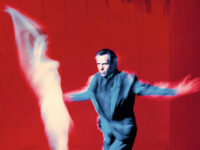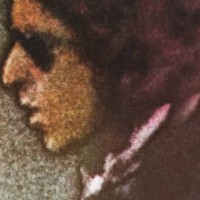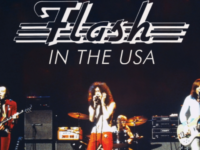Since appearing onstage dressed in a flower costume while with Genesis, Peter Gabriel continues to take fans on musical and visual twists and turns. His ability to write love songs that avoid easy cliches, and gift for writing powerful political statements that deeply move listeners, still amaze. Finally, his deeply expressive voice can softly croon one moment, then ascend to sonic heights the next.
His 1980s work virtually defined the decade. All of these aspects made me want to really like Gabriel’s forthcoming live album Live Blood an audio chronicle of his tour with the New Blood Orchestra. Recorded over two performances at London’s HMV Hammersmith Apollo in 2011, and due on April 24, 2012 from Eagle Rock, the two-CD compilation shows Gabriel in fine voice and spirits. However, the orchestral rearrangements of some of his classic tracks often sap their original emotional effect.
Performing tracks ranging from his 1977 debut to 2011’s New Blood, Gabriel at times radically reinterprets some familiar songs. “Biko” slowly builds to the track’s climax without the original thumping drums, the audience enthusiastically joining in the “whoa-oh-oh” chorus. This singalong, coupled with Gabriel’s still-piercing vocals, retain the track’s anger and indignation at Biko’s murder. Moving from rage to pure romanticism, his lovely cover of the Magnetic Fields’ “The Book of Love” benefits from an almost Baroque treatment.
[ONE TRACK MIND: Former Genesis guitarist Steve Hackett talks about key contributions to the band, the short-lived supergroup GTR – and how he created the move that made Eddie Van Halen famous.]
Not surprisingly, “Solsbury Hill” works well with the classical makeover, as the original recording featured strings. When Gabriel allows the audience to sing the “boom boom boom” line, and then hits the high notes when uttering the lines “’Hey,’ I said, ‘You can keep my things, they’ve come to take me home,'” one can sense the joy and energy emitted from performer and listener. A more subtle arrangement of the So track “Red Rain” strips bare the lyrics’ often anguished tone over acid rain: “And I can’t watch any more — no more denial,” he cries, his vocals emulating his outrage and sorrow.
While some songs benefit from the orchestral treatment, other seem to lose their context: “Digging in the Dirt,” a harrowing tale of Gabriel’s intensive therapy, initially featured a thumping electronic beat that increased in depth and volume when he shrieks “this time you’ve gone too far!” But the overall gentle rearrangement, along with the addition of a female singing partner, deprives “Digging in the Dirt” of its original jittery, somewhat ominous tone. Instead of describing a man in the grips of emotional crisis, digging deep into his soul to reveal past trauma, it now has a restrained, polite aura.
His curious cover of Paul Simon’s “Boy in the Bubble” (from Simon’s classic disc Graceland and also covered by Gabriel on 2010’s Scratch My Back) omits the original bouncy Afro-pop rhythm and turns it into a depressing dirge. The incredibly moving “Don’t Give Up” suffers from Kate Bush’s absence; she wrung every emotional drop from the lyrics, at times sounding weepy as she tirelessly urged on Gabriel to “Don’t give up now: We’re proud of who you are.” While New Blood singer Ane Brun certainly possesses a distinctive voice, she often sings over the words rather than considering each one. Similarly, Youssou N’Dour is greatly missed during “In Your Eyes.”
[ONE TRACK MIND: Legendary rock bassist Tony Levin digs into key cuts recorded alongside the likes of Peter Gabriel, King Crimson, Yes, Paul Simon and others.]
Another issue is the lack of visuals. Throughout his career, Gabriel has established himself as a performance artist as much as a rock star, and has used visuals from costumes to music videos to emphasize themes. During these concerts, the audience cheers during various songs, clearly reacting to the films and other effects shown during the performance. One gets the sense that just listening to the concerts detracts from the typical Gabriel multimedia experience.
Live Blood represents Gabriel’s willingness to take risks, which makes him a unique and influential figure in rock. While some of the orchestral rearrangements do raise the songs to a new meaningful level (such as the trippy, introspective “Downside Up”), others restrain Gabriel and the instrumentation too much, thus robbing the tracks of their initial impact.
Combining classical with rock is nothing new — consider Sting’s 2010 album Symphonicities — but the two do not always meld together. Sometimes the original track arrangement and instrumentation work the best, and do not need radical makeovers; much of Gabriel’s catalog is an example of this.
Despite its flaws, though, Live Blood does showcase something important: a clear, emotive, and impressively rangy voice that remains perfectly intact. Gabriel’s performance of the Us track “Blood of Eden” becomes a mini-drama, acted out through Gabriel’s soaring vocals. For that reason alone — practically a master class in singing — Live Blood is worth a listen.
[amazon_enhanced asin=”B007JQLNXG” container=”” container_class=”” price=”All” background_color=”FFFFFF” link_color=”000000″ text_color=”0000FF” /] [amazon_enhanced asin=”B000000OPU” container=”” container_class=”” price=”All” background_color=”FFFFFF” link_color=”000000″ text_color=”0000FF” /] [amazon_enhanced asin=”B005HS00XW” container=”” container_class=”” price=”All” background_color=”FFFFFF” link_color=”000000″ text_color=”0000FF” /] [amazon_enhanced asin=”B000000OSW” container=”” container_class=”” price=”All” background_color=”FFFFFF” link_color=”000000″ text_color=”0000FF” /] [amazon_enhanced asin=”B005HXGE9G” container=”” container_class=”” price=”All” background_color=”FFFFFF” link_color=”000000″ text_color=”0000FF” /]
- How John Lennon Came Roaring Back on the Beatles’ White Album - November 22, 2023
- Five ‘With the Beatles’ Deep Cuts That Illustrate Their Lasting Debt to R&B - November 20, 2023
- Five Must-Hear Deep Cuts from the Beatles’ ‘Past Masters’ - March 7, 2023




